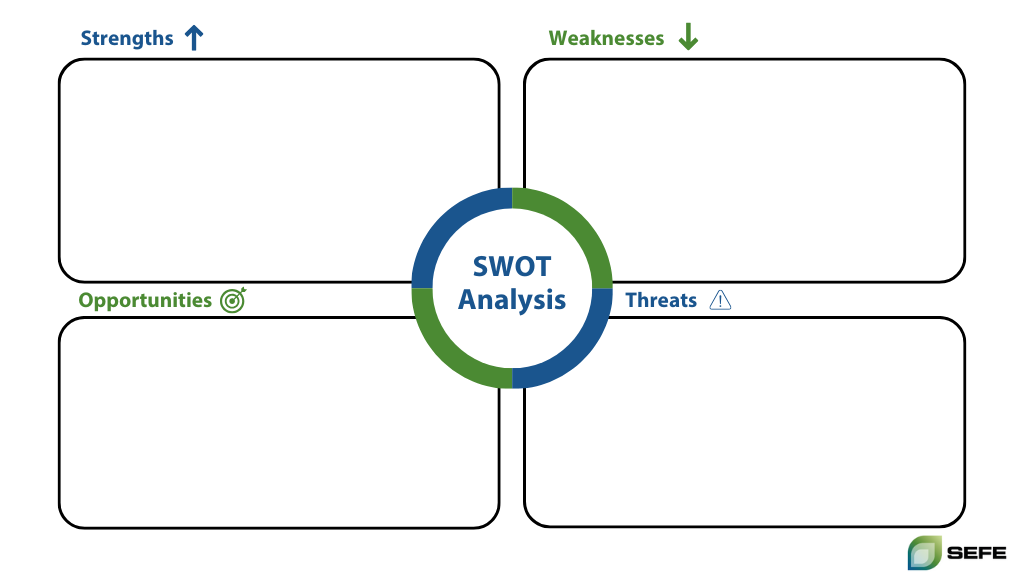How to conduct a SWOT analysis — with examples and template
Business growth doesn’t come without its share of challenges and opportunities. But when those arise, how do we prioritise them?
If you’re faced with multiple challenges, which issues need to be addressed first? And which of the new initiatives should take precedence over the others?
The answer lies in the SWOT analysis, a framework designed to help you maximise opportunities and minimise potential roadblocks on your path to success.
Whether you’re building a start-up or are supporting your established company, a SWOT analysis is a simple but powerful tool to shape your business strategy. In this guide, we’ll show you how to carry out a SWOT analysis, run through its benefits, show the process in action, and provide you with a template to help get you started.
What is SWOT analysis?
A SWOT analysis is a strategic planning technique to assess your business through the lens of the following aspects:
- Strengths
- Weaknesses
- Opportunities
- Threats

You can identify available resources for your organisation to reduce the chances of failure by understanding any blind spots and eliminating hazards.
This simple practice lets you make unbiased evaluations of things such as:
- Your business or brand
- Market positioning
- New projects or initiatives
- Specific campaigns or channels
When to use SWOT analysis
This type of analysis can be used at any time for businesses of all sizes in any sector. Because it can be tailored to your specific goals and areas of improvement, it can be the perfect tool to use before making any big decisions or creating your next business strategy. It can also be used to evaluate progress if you’re mid-way through a campaign or implementing new software. The information from the analysis allows your company to make smarter decisions that capitalise on your strengths, help you plan ahead for potential obstacles and keep on top of risks.
The SWOT analysis process: Step-by-step
Step 1: Get the right people together
The beauty of a SWOT analysis is that the outcomes you reach aren’t limited to founders and senior management – anyone can pitch in. In fact, it’s certainly a case of “the more, the merrier”; the greater the volume of input, the more suggestions you have to work with.
Make sure the people you gather are from different parts of your company, and that you have a broad representation of departments and teams. Different groups within your company will vary in their perspectives – a critical component of a successful SWOT analysis.
By engaging your employees in the process, you may see more buy-in on the strategic decisions that the analysis resulted in too.
Step 2: Identify your objective
Before writing anything down, decide what you need to evaluate through SWOT. Being specific allows you to tailor your evaluation and uncover actionable insights without being too broad.
Step 3: Host a brainstorming session
Once you’ve agreed an objective, host a brainstorming session with your chosen group. Here, you’ll list strengths, weaknesses, opportunities and threats or ask participants to create and submit lists individually.
Whichever approach you go for, include everything that comes up in each category. Each observation is crucial at this stage; just make sure everyone’s voice is heard and that you note down all suggestions.

Step 4: Rank the ideas
When you’ve organised all your ideas, it’s time to rank them. Everyone in the group should have several votes to distribute as they see fit. Soon, you’ll have a prioritised list of ideas with a clear pattern of the areas you need to focus and decide on regarding your business strategy.

What are the benefits of a SWOT analysis?
Cost-effective
It costs nothing to conduct a SWOT analysis, nor does it require any technical skill or formal training. Anyone who understands the business can perform it.
Highly applicable
Because it can identify any environmental factors that play either a favourable or unfavourable role in a particular objective, you can use SWOT analysis in a wide range of applications, from competitor analysis to strategic planning.
Promotes discussion
Since it involves discussing core company strengths and weaknesses, SWOT analysis underlines the important role that employees have to drive an organisation to succeed, allowing everyone to be on the same page throughout the SWOT analysis discussions.
Provides a visual overview
The SWOT analysis template usually takes the form of a square, with each quadrant representing strengths, weaknesses, opportunities and threats. This visual arrangement gives you an overview of the company’s position in a simple, digestible way.
Integration and synthesis
Carrying out a SWOT analysis means information, whether it’s known or recently acquired, can be integrated and synthesised together, organising disparate sources in one place.
Fosters collaboration
Through the discussion mentioned above, SWOT analysis creates a greater sense of collaboration and exchange of information between teams and departments that would rarely interact otherwise. This allows you to solve problems, resolve disagreements, and instil a stronger, more harmonious working environment.

Strategic clarity
SWOT analysis can give you an increased sense of confidence when creating your business strategy. Whether you’re looking ahead to the next financial quarter or the upcoming year, understanding your strengths, weaknesses, threats, and opportunities will be useful for shaping an effective plan addressing the needs of the company.
Enhanced focus
Having dedicated time to hone in on these four categories allows your team to remain focused on the goals of the business and how this can be used to support operations, processes and departments moving forward. It can be easy to become caught up with wanting to action changes but being unsure where to start, so this framework is a great starting point.
Supports resource allocation
If you’re struggling to decide where resources should be spent, this template can help steer you in the right direction, depending on your goals. For example, if you’re trying to increase profits and notice obstacles that could prevent you from improving cash flow when you’re looking at threats, you can look for opportunities that might minimise these.
Your SWOT analysis template
To help get you started, your SWOT analysis quadrant should contain:
- Strengths: What are you doing well? Think about the things that are going in your favour, along with the unique selling points your competitors simply don’t offer. Creating a list of your strengths across the business can show you which processes are ticking along nicely and can also help with the next step of highlighting any weaker areas you could work on. Starting with this will put your team in a good mindset since it shows you where your achievements lie.
- Weaknesses: What’s getting in the way of your goals? It could be areas of the business that are least profitable, certain resources that are lacking, or systems that cost you too much money. Collecting input from different departments and staff at all levels is crucial here since they could help you identify issues you might not have otherwise been aware of.
- Opportunities: Once you’ve identified your weaknesses, you can use these to spot potential opportunities for improving various parts of your business. Depending on your objectives, it can be helpful to ask questions like “what new target audience do I want to reach?”, “how can we stand out amongst our competitors?”, and “what technologies do I want to use to make business more effective?”. Spend a considerable amount of time brainstorming different ideas with a small group, and be sure to get further input from departments across the company who might have spotted department or even role-specific opportunities.
- Threats:What obstacles might stop you from realising the opportunities you’ve identified? Whether you could be hindered by ill-equipped software or budget issues, writing down any threats helps you to be more objective in your evaluations and come up with solutions that could remove these roadblocks to success.
We’ve created our own SWOT analysis template, which is available below to download, print and fill in for your business.
Download SWOT analysis template here.
An example of SWOT analysis in action
SWOT analysis can be applied to all types of businesses, whether they’re large multinationals or fledgling SMEs. Considering the guidance above, here’s what a SWOT analysis might look like for an energy business:
| Strengths
1. Established infrastructure 2. Positive relationship with existing customers 3. Rising investment in energy procurement |
Weaknesses
1. Rising cost of carbon fuel types 2. High employee turnover in some departments 3. Negative reviews from unhappy customers |
| Opportunities
1. Increased incentives for energy-efficient practices 2. Expanding market 3. Growing business with new recruitment opportunities |
Threats
1. New and emerging competitors 2. Increasing move towards low-carbon energy 3. Climate change policies |
Click here for the latest news and features from SEFE or visit our homepage to find out about our latest career opportunities.
The views, opinions and positions expressed within this article are those of our third-party content providers alone and do not represent those of SEFE. The accuracy, completeness and validity of any statements made within this article are not guaranteed. SEFE accepts no liability for any errors, omissions or representations.








